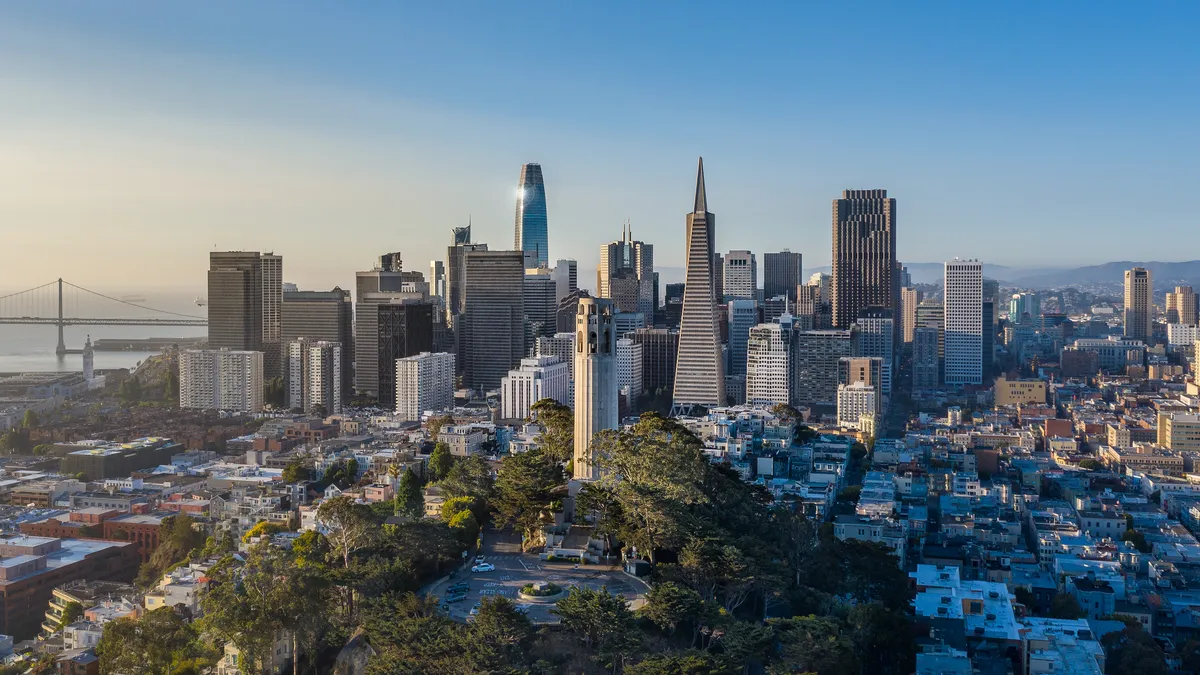Dive Brief:
- A new initiative from the San Francisco nonprofit Downtown Community Benefit District (Downtown CBD) will develop an action plan to "reimagine" 43 blocks of downtown neighborhoods to address the impacts of the COVID-19 pandemic.
- Downtown CBD selected San Francisco-based urban design firm SITELAB urban studio to develop a set of recommendations to rethink the Financial District and Jackson Square historic district, which have seen visitation and business decline in the pandemic. The two groups will gather community input and coordinate with the city on a set of guidelines to make the area more vibrant and engaging for residents and adapt to a future that might not include traditional 9-to-5 commuting patterns.
- “It is my vision that we promote downtown as everyone’s neighborhood so San Francisco residents can feel comfortable coming to live, work and play here,” said Robbie Silver, executive director of Downtown CBD. He added that the area had already been evolving, but the pandemic “really enacted a sense of urgency.”
Dive Insight:
With office workers staying home during the pandemic, business-oriented downtowns emptied out. A recent report from the Urban Land Institute and PwC US, based on input from nearly 1,700 real estate experts, found that downtown areas will need flexibility, especially if workers continue on partially remote schedules that keep offices from being at full capacity. The effects, the report found, won’t only impact offices, but also the restaurants and shops that rely on office workers.
Silver said that the Financial District, which is the center of the new initiative, is a prime example of an urban space that suffered in the pandemic. The area, he said, was defined by “bankers in suits working 9-to-5, maybe having a drink after dinner and then taking transportation home.” Like many business improvement districts, Downtown CBD started in January 2020 with goals that include improving the district's cleanliness and safety, creating and marketing an identity for the district and "activating" its public spaces, but it has now pivoted to look more holistically at the region.
Laura Crescimano, co-founder and principal at SITELAB, said the initiative is about “actions that can help downtown move into its next era,” with an eye toward how urban design “is the glue that holds us together.” The group will organize engagement sessions from communities across the city to get a sense of how people view downtown and what they would like to see the district offer. The groups will then work with city officials and the mayor’s office to develop recommendations and an action plan, covering everything from public art to retail spaces to community programming.
“If you look at European downtowns and other cities with vibrant downtowns, they serve more a multi-function, multi-purpose role,” Crescimano said. “What that ‘multi-’ means for us is one of the big questions we need to answer.”
Cities across the country are looking at how to make their downtown areas more inviting and flexible. In Boston, biotech labs are moving into empty office buildings. Cities have offered incentives for restaurants to move tables outdoors and create more appealing open spaces in downtown areas. Open streets programs have also redesigned some urban corridors with public art and performances, including in New York City’s Meatpacking District.
A 2020 report from the Boston University Initiative on Cities, based on a survey of 130 mayors, found that 60% of the respondents felt downtown office buildings would be “less desirable” in the future. But Katharine Lusk, co-director of the initiative, said the 2021 survey, due out this month, showed that mayors now have fewer concerns about the shift to remote work. “We suspect the worst case predictions about downtowns haven’t been realized in most of the country,” Lusk said in an email.
Downtown CBD and SITELAB said it is too early to know what sort of changes downtown San Francisco might adopt. In the short term, Silver’s group is planning its first outdoor public art event, a projection mapping of local artists' work that will light up four downtown properties in December, which he said will offer a jump-start to the neighborhood revitalization.











